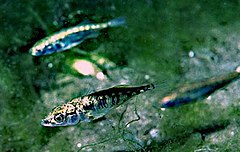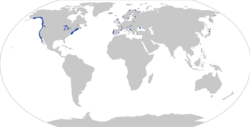| Three-spined stickleback | |
|---|---|

| |
| Scientific classification | |
| Domain: | Eukaryota |
| Kingdom: | Animalia |
| Phylum: | Chordata |
| Class: | Actinopterygii |
| Order: | Perciformes |
| Family: | Gasterosteidae |
| Genus: | Gasterosteus |
| Species: | G. aculeatus
|
| Binomial name | |
| Gasterosteus aculeatus | |
 | |
| Distribution of Gasterosteus aculeatus, with observations (dots; based on [2]) and distribution (shaded area; based on https://nas.er.usgs.gov/queries/factsheet.aspx?SpeciesID=702) | |
| Synonyms[3] | |
|
List
| |
The three-spined stickleback (Gasterosteus aculeatus) is a fish native to most inland and coastal waters north of 30°N. It has long been a subject of scientific study for many reasons. It shows great morphological variation throughout its range, ideal for questions about evolution and population genetics. Many populations are anadromous (they live in seawater but breed in fresh or brackish water) and very tolerant of changes in salinity, a subject of interest to physiologists. It displays elaborate breeding behavior (defending a territory, building a nest, taking care of the eggs and fry) and it can be social (living in shoals outside the breeding season) making it a popular subject of inquiry in fish ethology and behavioral ecology. Its antipredator adaptations, host-parasite interactions, sensory physiology, reproductive physiology, and endocrinology have also been much studied. Facilitating these studies is the fact that the three-spined stickleback is easy to find in nature and easy to keep in aquaria.[4]
- ^ NatureServe. (2019). "Gasterosteus aculeatus". IUCN Red List of Threatened Species. 2019: e.T8951A58295405. doi:10.2305/IUCN.UK.2019-2.RLTS.T8951A58295405.en. Retrieved 28 November 2022.
- ^ Fang, Bohao; Merilä, Juha; Ribeiro, Filipe; Alexandre, Carlos M.; Momigliano, Paolo (2018). "Worldwide phylogeny of three-spined sticklebacks". Molecular Phylogenetics and Evolution. 127: 613–625. doi:10.1016/j.ympev.2018.06.008. PMID 29906607. S2CID 49231567.
- ^ Froese, Rainer; Pauly, Daniel (eds.). "Gasterosteus aculeatus". FishBase. June 2022 version.
- ^ Barber, Iain (2013). "Sticklebacks as model hosts in ecological and evolutionary parasitology". Trends in Parasitology. 29 (11): 556–566. doi:10.1016/j.pt.2013.09.004. PMID 24145060.
